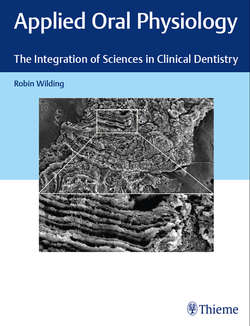Читать книгу Applied Oral Physiology - Robin Wilding - Страница 80
На сайте Литреса книга снята с продажи.
4.3.10 Periodontal Disease
ОглавлениеA cessation of oral hygiene also brings about a shift in the oral environment, which alters the balance of plaque organisms in the gingival sulcus. These sulcus organisms are more anaerobic than plaque organisms of the enamel surface, and their source of nutrition contains a greater proportion of proteins from the gingival fluid. If plaque of the gingival sulcus is not regularly removed by oral hygiene, the GCF flow increases, the pH increases, and there is a shift toward more anaerobic, gram-negative, non-sugar metabolizing (asaccharolytic) species. These include P. gingivalis, spirochetes, Fusobacterium nucleatum, and Tannerella forsythia. The resultant inflammation of the gingival tissues may progress to periodontitis, an inflammation which involves loss of the epithelial attachment to the tooth and destruction of bone. Although P. gingivalis is not present in large numbers, it functions as a keystone species. It achieves the orchestration of other symbionts in the shift toward pathobionts in the following ways:
Table 4.1 A comparison between five key features of noncarious plaque (NCP) and carious plaque (CP)
| NCP | CP | |
| Lactic acid | + | + + |
| Streptococcus mutans | + | + + |
| Streptococcus sanguis | + + | + |
| Actinomyces | + + | + |
| Sucrose metabolism | + | + + + |
• It produces isobutyric acid which stimulates the growth of the spirochete T. denticola.
• It releases proteases which degrade the proteins of the GCF making them available as nutrients for other members of the consortium.
• It interferes with cross-talk between complement and neutrophils so as to ensure its own survival.
• It manipulates and depresses the host immune response by entering neutrophils in the lamina propria, preventing their killing ability, thus preserving itself and other bacteria.
The progressive tissue damage to the periodontium is brought about in part by the host's own defense mechanisms. In response to lipopolysaccharides on the cell membrane of P. gingivalis, neutrophils migrate into the junctional epithelium and phagocytosis the bacteria. Their own subsequent death and autolysis cause the release of lytic enzymes which further damage the gingival sulcus tissues. The inflammation caused tends to further increase the exudate into the gingival sulcus of nutrients which further gives support to the pathobiont organisms in the consortia. In addition to P. gingivalis, these include Prevotella intermedia, Tannerella forsythia, and Treponema denticola.
The resultant inflammation of the gingival tissues may progress to periodontitis, an inflammation which involves loss of the epithelial attachment to the tooth and destruction of bone.
The presence of destructive periodontal disease allows blood-borne migration of P. gingivalis and colonization of brain and cardiovascular tissues. P. gingivalis has recently come under scrutiny as a cause of cardiovascular diseases and Alzheimer's disease. The capacity of P. gingivalis to enter and survive within immune cells and, to some extent, alter the behavior of these cells may explain its ability to colonize distant tissues such as the coronary arteries and to bypass the blood–brain barrier and enter brain tissue. After some years, during which it has infected neurons and spread along nerve axons, it may emerge out of the host cell and release toxic proteases such as gingipains. These enzymes break up tau and ubiquitin proteins which are essential supporting elements of neural tissue. Ubiquitin stabilizes amyloid protein thereby preventing the accumulation of malformed amyloid precursor proteins which are associated with Alzheimer's disease. There is evidence that the progression of Alzheimer's disease and vascular sclerosis of coronary arteries, is caused by P. gingivalis
